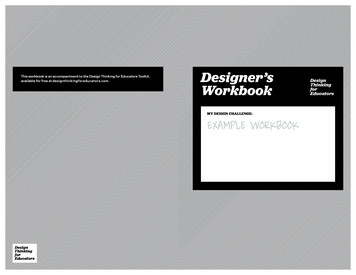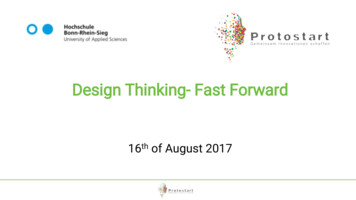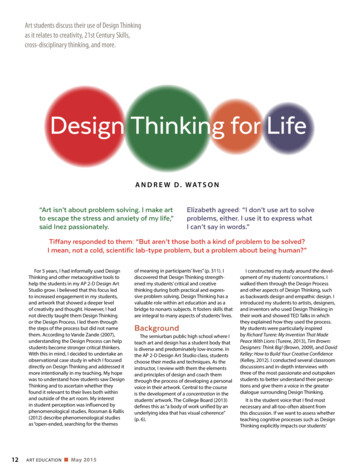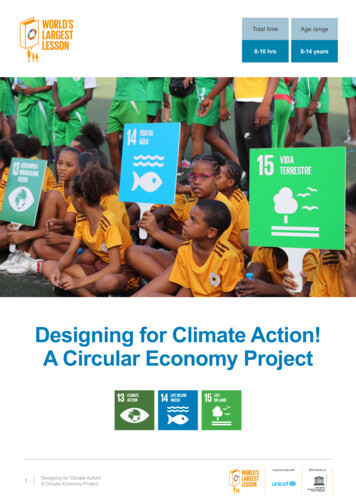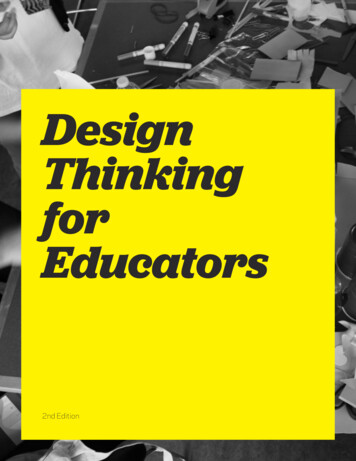
Transcription
DesignThinkingforEducators2nd Edition
DT for Ed Toolkit2How might my classroom be redesignedto better meet my students’ needs?Michael Schurr, a 2nd grade teacher in New York, realized that he never asked hisstudents what would make them comfortable in the classroom. He decided to talkdirectly with his students to figure out the best design for their environment.Based on his students’ input, he was able to redesign his classroom to betteraddress the needs and desires of his students. He lowered the bulletin boardsso that his students could actually see the content he’d spent hours assembling,and created a more comfortable semi-private space for the students to studyby rethinking the student cubby space. His students are more engaged andmove more fluidly in the classroom space. Now Michael consistently engages hisstudents in helping him more effectively shape their learning experience.Michael is using design to re-imagine his classroom through the lensof his students’ eyes.Teacher-designed
DT for Ed Toolkit3How might we create a 21st centurylearning experience at our school?The faculty at Ormondale Elementary School in California wondered if theywere preparing their students well for the future. They decided it was time tocollaboratively design an approach to teaching and learning that they felt wasupdated and relevant for the 21st century.Collectively, they embarked on a design journey and came to an approachthey call “Investigative Learning,” which addresses students not as receiversof information, but as shapers of knowledge. The faculty continues to evolveand share this approach with new teachers through the creation of a Manualof Investigative Learning to keep track of their philosophy and methods. Theyhave gained support from their school board, and have become recognized as aCalifornia Distinguished School.The faculty at Ormondale Elementary School uses design to address theneeds of their evolving student body.School-designed
DT for Ed Toolkit4How might we redesign our approach tocurriculum development and deliveryto center around the needs and desiresof our teachers and students?With a movement toward student-centered and personalized instruction, theHoward County Public School System in Maryland is using Design Thinking totackle next generation curriculum redesign incorporating 21st Century skills.Currently, there is a disconnect between the existing paper-based curriculum andthe interactive digital resources that are now available anytime, anywhere forteachers and students.Tapping into teacher, parent, and student behaviors in and outside of school,the design team collected inspiration around the ways that people engage withinformation and interact with curricular materials. Understanding the desiresof teachers, students, parents and administrators has helped the team rethinkcurriculum delivery as well as develop resources to replace, augment, andenhance current curriculum documents.Howard County is using design to re-conceptualize curriculum creation anddelivery to meet the needs of all learners.District-designedSchool-designed
DT for Ed Toolkit5How might we redesign our high schoolto elevate student engagement andacademic outcomes?Consistent low student achievement results at Castle High School in Hawaiidemonstrated the need for a redesign and restructure of the school. DesignThinking Hawaii, a non-profit organization that engages volunteers to applyDesign Thinking to big challenges, partnered with the Hawaii Department ofEducation to reimagine the Castle High experience.Through a series of mini-charettes, Design Thinking Hawaii has collected theneeds and interests of learners, teachers, and families and engaged the largercommunity to imagine new solutions that could help the school be more effective.The adopted plan captured the community’s priorities in new content andstructures, and Complex Area Superintendent Lea Albert is enabling the schooland community to prototype and iterate core curriculum, character education,and support services. This is the first public-school model in Hawaii to co-designits offerings with community, targeting systemic educational problems.Design Thinking Hawaii is using design to provide the state with input thatwill shape the redesign of Castle High and other schools in the community.Community-designed
“ Students just aren’tinterested in learningabout fractions.”“There is no teachercommunity network.”“ The pick-upand drop-offprocess atschool is anightmare.”There are a lot of problems in educationtoday but each of these concerns canbe seen as an opportunity for you todesign new, improved solutions for yourclassrooms, schools and communities.“Communicationwith parentsisn’t effective.”“I just can’t get mystudents to payattention.”DT for Ed Toolkit6“The schoolpick up anddrop offprocess ischaos.”“ The classroomorganization doesn’taccommodatedifferent learningmodes and shiftingclass sizes.”“ Effectively managing multiplelearning-levels in one classroomfeels impossible.”“ Current communication betweenadministration and teachers doesn’tgive everyone a voice.”
“Students come toschool hungry and can’t“ The assessment rubricfocus on the work.”doesn’t accuratelyrepresent learning.”The needs of today’s learners are evolvingas rapidly as the technologies that competefor their attentions. At the same time, ourorganizations and systems are stretchedto their limits to keep up with the changingdemands of the times. As an educator, youare distinctly positioned to keep a pulseon students’ evolving needs making you uniquely qualified tounderstand and design for thechanging needs of our schools.With over 3 million teachersin the US alone, and with avast international network ofenthusiastic educators, youstand in force on the front-lines ofK-12 education. Existing schoolprocesses and currciulum are structured toaddress district and state wide needs, butevery school is different.“I feel soalone in mywork.”“Parents don’tsupport homelearning.”DT for Ed Toolkit7But, because you understand your studentsand your school like no one else, it is youropportunity—and your responsibility—tocreate solutions for the challenges youand your school face everyday. As Einsteinfamously said, “We can’t solve problems byusing the same kind of thinking we used whenwe created them.”Wherever they fall on the spectrum of scale—from an interaction with a student to engagingparents to managing your schedule todeveloping whole new approaches to systemwide reform — the challenges facing educatorsare real, complex, and varied. And they neednew answers. As such, they require newperspectives, new tools, and new approaches.Design Thinking is one ofthese approaches.“ We’re not preparingour kids adequatelyfor the future.”“ School schedules don’t“ District-wide changes don’t align with teaching andauthentically accommodate learning rhythms.”differing communities.”
DT for Ed Toolkit8I have seen teachers start to redesign their classroom spaces byinterviewing their students.and develop new curricula by brainstormingand then prototyping out a unit.The fact that teachers are using humancentered design techniques to understand their students better makesstudents feel more engaged in the changing learning environment.The fact that the teacher is becoming the designer of his or her ownclassroom experience professionalizes the role of the teacher and allowsfor the most valuable change–authentic change driven by the students’needs rather than a school or district mandate.Design thinking is a creative act and lets teachers understand that theact of creating a really effective learning environment is an art thatis both reflective and intentional. If we want to change education andlearning to make it more relevant, more effective and more enjoyablefor all involved, teachers need to be the entrepreneurial designers andredesigners of the “systems” of schools and of the schools themselves.Dominic, Head of School
DT for Ed Toolkit9ContentsThis toolkit is for you.10What is Design Thinking?11What can I use Design Thinking for?12What does Design Thinkinglook like in action?13The Design Process14If you only remember a few things 160. Getting Started181. Discovery241-1 Understand the Challenge261-2 Prepare Research291-3 Gather Inspiration332. Interpretation382-1 Tell Stories412-2 Search for meaning432-3 Frame Opportunities463. Ideation483-1 Generate Ideas503-2 Refine Ideas544. Experimentation564-1 Make Prototypes584-2 Get Feedback605. Evolution665-1 Track Learnings685-2 Move Forward70AppendixGetting Started Worksheets7576
DT for Ed Toolkit10This toolkit isfor you.This toolkit can help you create solutions for everyday challenges.The toolkit offers you new ways to beintentional and collaborative whenyou are designing new solutions foryour classroom, school, and community. It hones your skills and empowers you to create desirable solutions.In this toolkit, we have layed outa series of steps that can help youdevelop new, innovative solutionsdesigned with people at the center.more fungettingunstuckimprovedcollaborationWhat will DesignThinking get me?effective ways toengage studentsThis toolkit equips you with the process and methods of design so youcan be more intentional about facing and solving for your current challenges. Businesses, social entrepreneurs and other innovators haveused thse methods for decades tocreate solutions for many differenttypes of challenges.As educators, you are alreadydesigning every single day—whether it’s finding new ways toteach content more effectively,using your classroom space differently, developing new approaches toconnecting with parents, or creatingnew solutions for your school.We know that your time is preciousand demands are high, and it mayoften feel that the system in whichsolutions thatfit my individualclassroom, schoolor districtmore creativeconfidenceyou educate is not as nimble as necessary to keep up with the rapidlyevolving demands. However, youalready possess the skills to solvefor these kinds of challenges.The methods in this toolkit areadapted specifically for you and giveyou the flexibility to work within yourexisting constraints.This is an invitation to experimentwith design processes. Let it inspireyou to approach challenges differently and experience how DesignThinking adds a new perspective toyour work.
DT for Ed Toolkit11What isDesign Thinking?Design Thinking is a mindset.Design thinking is about believing wecan make a difference, and having anintentional process in order to get to new,relevant solutions that create positiveimpact.Design Thinking gives you faith in yourcreative abilities and a process for transforming difficult challenges into opportunities for design.It’s Human-Centered. DesignThinking begins from deep empathyand understanding of needs andmotivations of people—in this case,the students, teachers, parents,staff and administrators who makeup your everyday world.It’s Collaborative. Several greatminds are always stronger whensolving a challenge than just one.Design Thinking benefits greatlyfrom the views of multiple perspectives, and others’ creativity bolstering your own.It’s Optimistic. Design Thinking isthe fundamental belief that we allcan create change—no matter howbig a problem, how little timeor how small a budget. No matter what constraints exist aroundyou, designing can be an enjoyableprocess.It’s Experimental. Design Thinkinggives you permission to fail and tolearn from your mistakes, becauseyou come up with new ideas, getfeedback on them, then iterate.Given the range of needs yourstudents have, your work will neverbe finished or “solved.” It is always inprogress. Yet there is an underlyingexpectation that educators muststrive for perfection, that they maynot make mistakes, that they shouldalways be flawless role models. Thiskind of expectation makes it hardto take risks. It limits the possibilities to create more radical change.But educators need to experiment,too, and Design Thinking is all aboutlearning by doing.In short, Design Thinking is theconfidence that new, better thingsare possible and that you can makethem happen. And that kind of optimism is well-needed in education.
DT for Ed Toolkit12What can I useDesign Thinking for?You can use Design Thinking to approach any challenge.However, there are a consistent set of challengesthat teachers and schools seem to face, and theycenter around the design and development of learning experiences (curriculum), learning environments (spaces), school programs and experiences(processes and tools), and system strategies, goalsand policies (systems).Sometimes these challenges are tackled by a district team—especially for the more complex challenges that involvemultiple stakeholders; sometimes challenges are addressedat the school level, with a core team of representative educators driving the process; and sometimes these challenges areaddressed by educators or small teams of educators themselves which is where grassroots change begins to happen.CurriculumSpacesProcesses and toolsSystemsHow might I inspire students to engage inconcerns of the environment?How might I use my classroom space indifferent ways to help set my students atease?How might I engage parents as anintegrated part of their students’ learningexperience?How might we reinvision curriculum for anentire district while providing for individualschools’ differences?How might I create a comfortable spacethat meets the many needs my studentshave throughout the day?How might we recruit the best teachers toour school?How might we track the development ofstudents’ character traits over time tohelp shape our school philosophy moreintentionally?Every day you design ways to interact withyour students around content. You canfollow a design process to be more intentional about connecting this content to theinterests and desires of today’s learners byfinding out more about the things that theydo outside of school and connecting that tothe content you are bringing to them.How might I engage my students in compelling ways around learning world history?How might I develop students to be activeseekers of knowledge in subjects that theyhave little knowledge of?How might I help children from disadvantaged backgrounds increase theirvocabulary?The physical environment of the classroomsends a big signal about how you wantyour students to behave. Right now wetend to think of our classroom spaces asstandard kids in rows, sitting in desks.By rethinking the design of our spaces, wecan send new messages to our studentsabout how they should feel and interact inthe classroom.How might we reimagine our school’slibrary for the needs and interests oftoday’s learner?How might we create an exciting and effective space for teachers to collaborate?How might we design our high schoolcampus to best engage and supporttoday’s learner?Your school has already designed a set ofprocesses or tools that may or may not besetting up your school for success. This istypically outside of the classroom and specific interactions around learning, and morearound how the system operates. Everyprocess is already designed, and thuscan be redesigned! Sometimes creatingtools can be essential to supporting newlydesigned processes.How might we re-envision arrival anddeparture procedures at our school?How might we design ways to keep ourselves balanced and well?How might we redesign our school schedule to be centered around the needs oftoday’s families and teachers?Not everyone can always make decisionsfor the system that they exist within, buteveryone can contribute to the design ofthat system. Designing systems is aboutbalancing the complexity of many differentstakeholder needs with the needs of theoperation. When designing systems, we’reoften setting high-level strategy such asstating visions, priorities, policies, and keycommunications around these ideas.How might we connect more with ourneighborhood community?How might we use our school as an R&Dhub for schools nationwide?
DT for Ed Toolkit13What does Design Thinkinglook like in action?How Ormondale Elementary School redesignedtheir approach to teaching and utionA 2-day summer workshop kicked off the challenge, withan excercise which entailed teachers imagining one of theircurrent students in the year 2060. Based on understanding the goals and dreams of their students and families,coupled with the books they read about 21st centuryskills, the teachers collectively discussed the skills necessary for the students to succeed in the future. For furtherinspiration, the group visited outside organizations facinganalogous challenges.Several brainstorm ideas were prototyped which resultedin the emergence of a pattern across all the prototypes:the team was passionate about a teaching and learningapproach they called Investigative Learning. The approachaddressed the students not as receivers of informationbut as shapers of knowledge. They developed short- andlong- term plans for ideas they could try out, and the thingsthey’d like to learn more about in order to continually buildout this new approach over the school year.The group synthesized the research creating generativequestions, such as “How might we enable the globallyaware student?” and “How might we provide opportunitiesfor interest-driven learning?”Over the course of a year, many solutions were testedincluding diverse approaches to curriculum that integratedproject- and theme-based learning in the classroom. Theteachers created new communications for parents, andone teacher even received a grant to renovate a classroomand create a different learning environment for herstudents. Dedicated time in their weekly meetings wasset aside to discuss was happening and support and learnfrom each other.IdeationInitial brainstorm ideas included tools and classroomdesign and expanded to include curriculum and theeducational system as a whole.In the second year, the evolution continued with anotherworkshop to make sense of the experiments theyhad conducted around the school. They developed aframework for Investigative Learning experiences thatintegrated everyone’s approaches, created commonlyshared standards unique to their school that builtupon state standards, and created new assessmentapproaches. They created a “Manual of InvestigativeLearning” to help everyone have a shared reference andhave become recognized as a “California DistinguisedSchool.”
DT for Ed Toolkit14The DesignProcessThe design process is what puts Design Thinking into action. It’sa structured approach to generating and evolving ideas. It hasfive phases that help navigate the development from identifyinga design challenge to finding and building a solution.It’s a deeply human approach that relies on your ability to beintuitive, to interpret what you observe and to develop ideas thatare emotionally meaningful to those you are designing for—allskills you are well versed in as an educator.DiscoveryInterpretationMethods are the core piece of thistoolkit: they offer the actual instructions that help you put DesignThinking into action.There are many, in order to provideyou with a rich variety to choosefrom: every challenge requires a different approach and a different setof methods.IdeationIt often makes a lot of sense tofollow these steps in a linear way,especially when you’re starting out.But don’t feel restricted by that:only you know how to best usethis toolkit. Use it along with othermethodologies and theories youfind useful to develop ideas. Adaptit, annotate it, cut it up, reconstructit and make it your own.ExperimentationEvolution
DT for Ed Toolkit15Design xperimentationevolutionI have a challenge.How do I approach it?I learned something.How do I interpret it?I see an opportunity.What do I create?I have an idea.How do I build it?I tried something new.How do I evolve it?2–1 Tell Stories3–1 GenerateIdeas4–1 MakePrototypes5–1 TrackLearnings3–2 Refine Ideas4–1 GetFeedback5–2 MoveForwardSteps1–1 Understand theChallenge1–2 Prepare Research2–3 FrameOpportunitiesnumber of possibilities1–3 Gather Inspiration2–2 Search forMeaningThe Design Thinking processoscillates between divergent andconvergent thinking modes. It canbe helpful to be aware of the modethat corresponds to the designphase you are working through.
DT for Ed Toolkit16If you only remember afew things You are adesigner.Embrace yourbeginner’s mind.Become more intentional aboutyour design process.Approach problems as a novice even if youalready know a lot about them.Be confident in your creative abilities.Let yourself learn.Be strategic about what needs attention first.Be willing to experiment.Listen to your stakeholders and be inspired todesign for them.Be ok with not having the “right” answer.Trust that you’ll find one.It’s your opportunity, and your responsibility,to have an impact on the lives of your students and be part of changing and growingthe system.Stepping out ofProblems are justyour zone ofopportunities forcomfort learning. design in disguise.Get unstuck.Have an abundance mentality.Break your routine.Be optimistic.Use the world outside your classroom toinvigorate your work.Believe the future will be better.Analagous inspiration is your best friend.Leave your classroom.Collaborate with others.Start with, “What if?” instead of “What’s wrong?”
DT for Ed Toolkit17The design process has helped mesee that I have a responsibility to be achange agent for teaching and learning. I don’t need to have all the answers(or be perfect), but I need to be willingto try new things, dare to dream big,and be patient as I experiment with thedesigns that emerge in the process.Design Thinking has given me the toolsand empowerment to create meaningful educational change.—Meg Krause, 5th Grade teacher
DT for Ed Toolkit18Getting StartedWhat’s in this sectionDefine a ChallengeCreate a Project Plan1921
DT for Ed Toolkit19Getting Started30–60 minsReflective2–3 PeopleDifficult yThis gets youAn opportunity framedas a design challenge.Keep in mindDefining a challengeis an act of leadership.Look around you, seewhat you think shouldbe improved, and turnit into an actionablechallenge that you anda team can create newsolutions for. However,there is no “right” challenge to begin workingon. Just pick one thatyou are most excited tobegin working on andget started!Define a ChallengeEvery design process begins with a specific and intentional problem to address; thisis called a design challenge. A challenge should be approachable, understandable andactionable, and it should be clearly scoped—not too big or too small, not too vagueor too simple.List possible topicsFinding opportunities for design often comesfrom noticing problems. An experienced DesignThinker maintains a mindset which instinctivelyreframes problems into opportunities. Make a listof all the problems you’ve noticed or things you’vewished for.Frame the problemRewrite the problem statements into “how mightwe” questions in order to frame the problem as apossibility. Use the define a challenge worksheetto help create a “how might we” question.Keep it simple.Describe your challenge simply and optimistically. Make it broad enough to allow you todiscover areas of unexpected value, and narrowenough to make the topic manageable.Sketch out end goalsDefine your goals for undertaking this designchallenge. Be honest about determining a realisticscope of your project both regarding time andoutput. What will you work to produce? Wheredo you expect to get at the end of this process?If you are creating a solution for your classroom, itmay be something that will be easy for you to tryand implement. But sometimes you are creatingsomething that is beyond your direct skills, orsomething that involves many other people – suchas defining new attributes for your school library,Worksheet 1: Define a ChallengeUse the define a challenge worksheet in theDesigner’s Workbook or in the appendix to helpyou define a challenge you’re excited to tackle andto create a project plan to guide the project.or designing new processes for school drop off. Inthis case you might want to end with creating apresentation or a “pitch” to help engage others inyour design ideas.Before you dig into the specificsof your challenge, consider what might be the“deliverables” for this projectDefine measures of successWhat else are you working toward? Whatwill make this work successful? What are themeasures of success? Examples include numberof people who sign up for your program, storiesretold by parents, student excitement, etc. Mostof the time, these measures of success emerge asyou dig into your project, but it helps to start tothink about this at the onset.Establish constraintsIt is crucial to define constraints and get specificon the problem or question you are trying toaddress. Does it need to fit into a certain timeframe? Can it be integrated with an existing structure or initiative? Make a list of the constraints youneed to manage.Write a briefA clearly defined challenge will guide your questions and help you stay on track throughout theprocess. Write a short brief that clarifies the challenge you plan to address. Write it as if you werehanding it to someone else to design with. Capturethoughts on why this is a problem, and what theopportunity for design will be.
DT for Ed Toolkit20Getting StartedA design challenge is the starting point of every design process, and the purpose youwill work toward. Framing the right “How might we” question to address your challengeis essential. The question should be broad enough to allow for unexpected possibilitiesbut narrow enough to let you focus. Be careful not to include the answer in the question.Here are a few examples you can choose from, or use as inspiration to come up with achallenge that matters for you.CurriculumSpaceProcesses and toolsSystemsHow might we engage studentsmore deeply in reading?How might we design ourclassroom space to bestudent-centered?How might we build schoolfamily partnerships?How might we develop toolsthat help teachers collaborateacross our district’s schools?How might we bring the “real”Chinese community to myChinese classes, and enablemy students to make moreauthentic connections to theChinese World?How might we create a curriculum that teaches studentsabout the brain and about whothey are as learners?How might we create a spacefor teacher collaboration?How might we adapt the schoolschedule to the learningrhythms of our students?How might we redesign thelibrary to enable flexibilitybetween loud collaborative andquiet contemplative uses?How might we create a way tosystematically review, discuss,and support students at lowergrade levels?How might we support a morewell-rested campus?How might we design ourcampus to serve our studentsand the community?
DT for Ed Toolkit21Getting StartedCreate a Project Plan20-30 minsReflective1-2 PeopleDifficult yOnce you have decided which challenge to work on, you can start to plan your designproject. The first, and likely quite challenging, task will be to find the time for yourendeavor. Try to integrate Design Thinking into the existing structures of your school’sschedule. That will make it easier to follow through.You know your workplace, schedule, and priorities best. You can create your own planthat best fits into your unique configuration. Here are a few starting points for you.This gets youA clear timeline to guideyour design challenge.Keep in mindAs you dig into yourchallenge, you may findthat your plan needsto adjust because yourproject has taken anew direction. Let yourdesign process unfoldnaturally; don’t feel likeyou have to stick to theoriginal plan. However,remember that settingdeadlines can be helpful in propelling yourprocess forward.Do it in a dayTransform a professional development day into acollaborative design workshop. To make themost of the day, define a challenge, assemble ateam and identify sources of inspiration ahead oftime. The large amount of time set aside for a PDday is ideal for working through Interpretation,Ideation, and Experimentation. These are intenseand productive phases of the process, and willleave the team with tangible ideas as evidence ofyour progress. A professional development dayis also an ideal chance to go out into the worldand seek ionExperimentationEvolution5pmDoing a challenge in a day often results ininspiring new ideas, but doesn’t allow you thebenefit of trying the ideas out in order to learnmore about them. Consider spending time at theend of the day inviting teams of teachers tocommit to experimenting and evolving ideasafter this day, and share back learnings duringsome of your meetings over the merse over a week or two.Commit time during a prolonged break, such assummer, or holiday break, to dive into the designprocess. A continuous period of time allows for adeeper engagement with each phase. It’s anopportunity to experience the progressionbetween steps. During the rest of the year, youcan draw on what you learned during this time.It is amazing how far you can get in a shortamount of dedicated time.
DT for Ed Toolkit22Getting StartedDecide what challenge is appropriate for a year-long commitment. Consider multiplefactors, such as complexity, scope, peoples’ involvement and priority. Then make aproject calendar and commit to deadlines and goals, as they create a sense of progress.Agree on regular check-ins to keep the momentum going. Be intentional about howbest to match the flow of the project to the flow of the school terpretationMarc
Design Thinking is a mindset. It’s Human-Centered. Design Thinking begins from deep empathy and understanding of needs and motivations of people—in this case, the students, teachers, parents, staff and administrators who make up your everyday world. It’s Co
